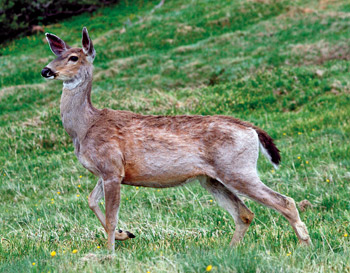|
 |
Adenovirus Hemorrhagic Disease (AHD) is an infectious, usually fatal disease of deer that is found in the western United States but can also be found in Canada, most recently in British Columbia.
AHD is similar to CWD in the way it is spread, through direct contact between deer and contact with fluids (saliva, feces, urine), particularly when animals are at high density, such as being fed in backyards. More concerning, it is suspected AHD can also be spread between animals by breathe.
AHD was first discovered in California in the 1990s. It mostly affects black-tailed deer (a subspecies of mule deer) but mule deer, white-tailed deer, elk, antelope, caribou, and moose are all susceptible, especially their fawns.
 |
| - black-tailed deer photo by Walter Siegmund |
The disease acts very fast and is fatal, as it damages small blood vessels in the lungs and intestines. Deer with AHD have difficulty breathing, diarrhea, and experience seizures. Other chronic symptoms include ulcers and abscesses in the mouth and throat that lead to the animal drooling, weight loss, and death. There is no treatment or vaccine for adenovirus hemorrhagic disease. However, there is no evidence that suggests AHD can be transmitted to humans, pets, or livestock.
Now, AHD is suddenly hitting black-tailed deer on Vancouver Island, and hitting them hard with hundreds of these deer simply dropping dead, many in people’s backyards.
The disease was first confirmed in BC deer last fall on several Gulf Islands, including Galiano, Mayne, Pender and Salt Spring Island, but has now, this fall, made its way to Vancouver Island where it continues to spread.
The BC government is warning hunters to “not to eat any meat from a deer that is found dead, appears ill, or is acting abnormally prior to death.”
Sound familiar?
To prevent the spread of AHD, the public is also being asked to not feed wildlife and to dispose of dead deer by deep burial.
So far this year, there have been outbreaks in California, Oregon, and Washington.
According to the Government of BC, “AHD can lead to localized and short term deer population reductions where it occurs;
however, this disease is still poorly understood and further research is needed.”
AHD is similar to other hemorrhagic diseases in wild animals such as bluetongue (most common in sheep) and Epizootic Hemorrhagic Disease (most common in white-tailed deer).
In an email from Alberta’s Provincial Wildlife Disease Specialist, Dr. Margo Pybus, “While factors that trigger outbreaks of the disease are not well known, there is no evidence that AHD flares up in Alberta.
“We had a few cases in young mulies in Waterton many years ago, but have seen nothing since.”
Alberta Environment and Parks staff have been made aware of the BC situation and have been advised to watch for any unusual reports of dead deer across southern Alberta. You can do your part too, if you are hunting in southern Alberta, please report the same to a Fish and Wildlife officer in the area.
It isn’t believed that AHD can kill off entire deer herds because unlike CWD, the disease is only spread by animal-to-animal contact, whereas chronic wasting disease can also be spread through shed prions, which can remain in the environment (plants and soil) indefinitely.
Just what we need... another disease to spread its ugly head! ■
For previous Outdoor Pursuits click here.
|
|
|
|


